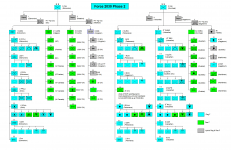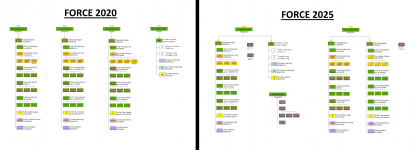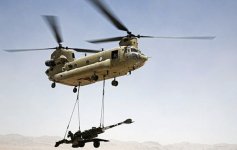Here's the latest Force 2025 recipe from the kitchen of GR66. It starts off with a healthy helping of KevinB, a dash of FJAG and a sprinking of Kirkhill and topped off with a few special ingredients of my own. Take a bite and let me know what ingredients you think should be changed...
Infantry
Starts with KevinB's idea of having both the 1st and 3rd Battalions of the RCR and PPCLI as Light Battalions and R22R as all LAV Battalions. I'd take it one step further and make 2 RCR a light battalion as well.
FJAG (and others) have noted "We're not committed to any rapid deployment interventionist or air-field seizing missions" but I agree with KevinB that a rapid reaction capability would be a contribution to our allies that would allow us to punch above our weight so to speak. It's a capability that only a handful of our allies have so would be highly valued. As for seizing airfields, etc. I agree that it's not a likely scenario, but like armour, AD, AT and SP artillery it's one of those capabilities that you'd greatly miss having if it is required. I don't think it means that we need to recreate the CAR, but if we continue with our current system of having one company in each Light Battalion as a parachute company, then we'd have 5 x jump companies available should the need arise.
Having 4 x LAV Battalions and 5 x Light Battalions (instead of the current 6 and 3) would allow us to manage readiness as follows:
LAV Battalions (4):
1 x Deployed
1 x High Readiness
1 x Road to High Readiness
1 x Reconstituting
Light Battalions (5):
1 x Deployed
1 x Rapid Reaction (72hr Standby)
1 x High Readiness
1 x Road to High Readiness
1 x Reconstituting
With this system we'd be able to have 2 x Battalions on Deployment (1 x LAV and 1 x Light), an additional two at High Readiness ready to replace them (or to deal with an emerging threat) and an additional Light Rapid Reaction Battalion on 72hr standby to deal with any rapidly developing threats.
Armour:
Personally I'd be in favour of retaining and upgrading the 82 x Leopards we have to a single variant. I agree that they are not as dominant on the battlefield as they once were, that an AH might provide more versatility and that there is a pretty high cost to maintain quite a small and difficult to deploy fleet. All that being said, we don't have an alternative platform to fulfill the role of the tank at the present time and it will be well beyond 2025/2030 before we have something coming online to replace them. So for now I'd keep them.
RCD
I'd have them switch locations with 2 RCR and co-locate them with the Armour School and concentrate all our tanks in the single Regiment. Here they would be closer to an embarkation point for shipping to Europe (the most likely place they'd be needed) and this is likely a skill that should be practiced annually.
12RBC
Loses the shared tank squadron and becomes a straight Recce Regiment. Moving forward I'd begin replacing some of the LAV Recce vehicles with LAV-based UAV launch platforms and LAV-based AT platforms.
LdSH
I'd give the Strathconas a similar mix of capabilities as 12RBC (recce/UAV/AT) but mounted on light, air-transportable vehicles to support our Light Battalions and to enable rapid deployment.
Artillery:
5 RALC & 1 RCHA
I'd re-equip these two Regiments with the same SP Artillery system that the US Army procures for its Stryker Brigades. Hopefully the reduced manning requirements for these guns would allow both Regiments to expand to 3 x Batteries and possibly even leave enough PYs left to be transferred to 2 RCHA.
2 RCHA
I'd keep the M777s for this Regiment and if enough PYs are saved by switching 5 RALC and 1 RCHA to a self-propelled platform then I'd either add a 3rd 4-gun battery or expand the existing batteries to 2 x 6-gun batteries. I'd have all of these batteries be jump qualified.
Engineers:
I'd have one jump qualified field squadron in each Regiment.
Equipment:
With the above changes to the structure of the Army, there would be 2 x Battalions of LAVs and 3 x Squadrons of Armoured Recce vehicles (plus more when additional Recce vehicles begin to be replaced with UAV-launch and AT variants).
I'd use 1 x Battalion of the LAVs, 1 x Armoured Recce Squadron, 1 x Battery of M777s (hopefully to be eventually replace with the new SP-Artillery vehicle) and 1 x Squadron of the upgraded Leopards to create a pre-positioned Canadian Battle Group in Europe - equipment only - as part of our deterrence against Russia (and to reinforce our Latvia contingent if required). Personally, I'd likely choose to place this pre-positioned force in Germany. If we place it too close to the potential front then it might be targeted for destruction in place before we can get there, or we might have to fly into contested airspace in order to meet up with our equipment. In a more limited conflict initiated by Russia they would be less likely to attack targets in Germany in hopes of avoiding a full-scale NATO response to an attack with limited territorial goals.
The remaining LAV Battalion vehicles I'd place as training company vehicles in Gagetown, Meaford and Wainwright for use of both the Reg Force Light Battalions and the Reserve Infantry Regiments to use for familiarization training.
The extra LAV Recce vehicles could be either used as conversion hulls for new variant vehicles, or parceled out to the infantry Recce Platoons or Reserve Armoured Recce Regiments.
This FORCE 2025 would look something like this:
View attachment 66232







